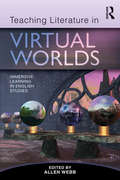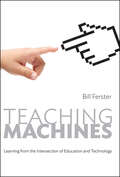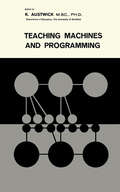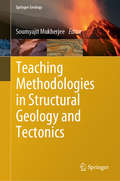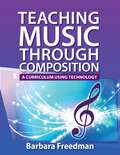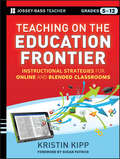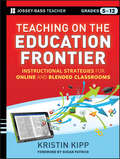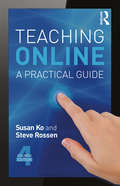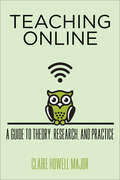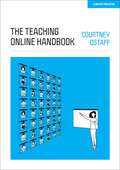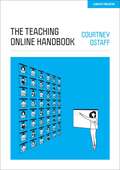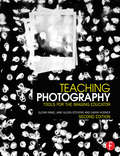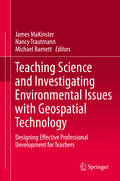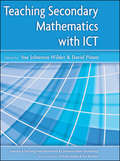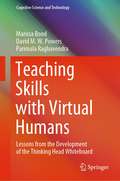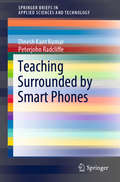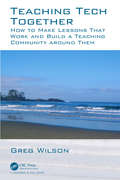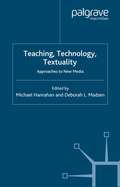- Table View
- List View
Teaching Literature in Virtual Worlds: Immersive Learning in English Studies
by Allen WebbWhat are the realities and possibilities of utilizing on-line virtual worlds as teaching tools for specific literary works? Through engaging and surprising stories from classrooms where virtual worlds are in use, this book invites readers to understand and participate in this emerging and valuable pedagogy. It examines the experience of high school and college literature teachers involved in a pioneering project to develop virtual worlds for literary study, detailing how they created, utilized, and researched different immersive and interactive virtual reality environments to support the teaching of a wide range of literary works. Readers see how students role-play as literary characters, extending and altering character conduct in purposeful ways ,and how they explore on-line, interactive literature maps, museums, archives, and game worlds to analyze the impact of historical and cultural setting, language, and dialogue on literary characters and events. This book breaks exciting ground, offering insights, pedagogical suggestions, and ways for readers to consider the future of this innovative approach to teaching literary texts.
Teaching Literature in Virtual Worlds: Immersive Learning in English Studies
by Allen WebbWhat are the realities and possibilities of utilizing on-line virtual worlds as teaching tools for specific literary works? Through engaging and surprising stories from classrooms where virtual worlds are in use, this book invites readers to understand and participate in this emerging and valuable pedagogy. It examines the experience of high school and college literature teachers involved in a pioneering project to develop virtual worlds for literary study, detailing how they created, utilized, and researched different immersive and interactive virtual reality environments to support the teaching of a wide range of literary works. Readers see how students role-play as literary characters, extending and altering character conduct in purposeful ways ,and how they explore on-line, interactive literature maps, museums, archives, and game worlds to analyze the impact of historical and cultural setting, language, and dialogue on literary characters and events. This book breaks exciting ground, offering insights, pedagogical suggestions, and ways for readers to consider the future of this innovative approach to teaching literary texts.
Teaching Machines: Learning from the Intersection of Education and Technology (Tech.edu: A Hopkins Series on Education and Technology)
by Bill FersterThe allure of educational technology is easy to understand. Classroom instruction is an expensive and time-consuming process fraught with contradictory theories and frustratingly uneven results. Educators, inspired by machines’ contributions to modern life, have been using technology to facilitate teaching for centuries.In Teaching Machines, Bill Ferster examines past attempts to automate instruction from the earliest use of the postal service for distance education to the current maelstrom surrounding Massive Open Online Courses. He tells the stories of the entrepreneurs and visionaries who, beginning in the colonial era, developed and promoted various instructional technologies. Ferster touches on a wide range of attempts to enhance the classroom experience with machines, from hornbooks, the Chautauqua movement, and correspondence courses to B. F. Skinner’s teaching machine, intelligent tutoring systems, and eLearning. The famed progressive teachers, researchers, and administrators that the book highlights often overcame substantial hurdles to implement their ideas, but not all of them succeeded in improving the quality of education. Teaching Machines provides invaluable new insight into our current debate over the efficacy of educational technology.
Teaching Machines: Learning from the Intersection of Education and Technology (Tech.edu: A Hopkins Series on Education and Technology)
by Bill FersterThe allure of educational technology is easy to understand. Classroom instruction is an expensive and time-consuming process fraught with contradictory theories and frustratingly uneven results. Educators, inspired by machines’ contributions to modern life, have been using technology to facilitate teaching for centuries.In Teaching Machines, Bill Ferster examines past attempts to automate instruction from the earliest use of the postal service for distance education to the current maelstrom surrounding Massive Open Online Courses. He tells the stories of the entrepreneurs and visionaries who, beginning in the colonial era, developed and promoted various instructional technologies. Ferster touches on a wide range of attempts to enhance the classroom experience with machines, from hornbooks, the Chautauqua movement, and correspondence courses to B. F. Skinner’s teaching machine, intelligent tutoring systems, and eLearning. The famed progressive teachers, researchers, and administrators that the book highlights often overcame substantial hurdles to implement their ideas, but not all of them succeeded in improving the quality of education. Teaching Machines provides invaluable new insight into our current debate over the efficacy of educational technology.
Teaching Machines and Programming
by K. AustwickTeaching Machines and Programming covers the significant developments in teaching machines and automated teaching, as well as the major theoretical issues and attributes involved in these procedures. After a brief introduction to teaching machine procedures, this six-chapter text goes on summarizing the industrial and military applications of teaching machines. The succeeding chapters consider the underlying theory, function, and schema of the adaptive teaching system, which are related to recognizable teaching functions performed by a human tutor. The last chapters discuss the development and features of linear programs and their application as new teaching aid. These chapters also look into some practical problems arising in programming for schools. This book will prove useful to computer programmers, school administrators, teachers, and students.
Teaching Methodologies in Structural Geology and Tectonics (Springer Geology)
by Soumyajit MukherjeeThis edited book discusses various challenges in teaching structural geology and tectonics and how they have been overcome by eminent instructors, who employed effective and innovative means to do so. All of the chapters were written by prominent and active academics and geoscientists fully engaged in teaching Structural Geology and Tectonics. New instructors will find this book indispensible in framing their teaching strategy. Effective teaching of Structural Geology and Tectonics constitutes the backbone of geoscience education. Teaching takes place not only in classrooms, but also in labs and in the field. The content and teaching methodologies for these two fields have changed over time, shaped by the responsibilities that present-day geoscientists are expected to fulfill.
Teaching Music Through Composition: A Curriculum Using Technology
by Barbara FreedmanTeaching Music through Composition offers a practical, fully multimedia curriculum designed to teach basic musical concepts through the creative process of music composition. Author and award-winning music educator Barbara Freedman presents classroom-tested ways of teaching composition with technology as a tool with which students can create, edit, save, and reproduce music. As Freedman demonstrates, technology allows a musical experience for all skill levels in opportunities never before available to compose manipulate, instantly listen to music electronically and even print standard Western music notation for others to play without having to know much about traditional music theory or notation. All students can have meaningful hands-on applied learning experiences that will impact not only their music experience and learning but also their understanding and comfort with 21st century technology. Whether the primary focus of your class is to use technology to create music or to explore using technology in a unit or two, this book will show you how it can be done with practical, tried-and-true lesson plans and student activities.
Teaching Music Through Composition: A Curriculum Using Technology
by Barbara FreedmanTeaching Music through Composition offers a practical, fully multimedia curriculum designed to teach basic musical concepts through the creative process of music composition. Author and award-winning music educator Barbara Freedman presents classroom-tested ways of teaching composition with technology as a tool with which students can create, edit, save, and reproduce music. As Freedman demonstrates, technology allows a musical experience for all skill levels in opportunities never before available to compose manipulate, instantly listen to music electronically and even print standard Western music notation for others to play without having to know much about traditional music theory or notation. All students can have meaningful hands-on applied learning experiences that will impact not only their music experience and learning but also their understanding and comfort with 21st century technology. Whether the primary focus of your class is to use technology to create music or to explore using technology in a unit or two, this book will show you how it can be done with practical, tried-and-true lesson plans and student activities.
Teaching Of Computer Science
by P.N. Lakshmi ShanmugamThis book has been written as a basic textbook for B.Ed student teachers who have chosen one of the optional subjects as computer science -I studying in the B.Ed colleges affiliated to Tamil Nadu Teachers Education University. The importance of systematic and organized knowledge can hardly be exaggerated in this book. Ten chapters namely Hardware and Software, Aims of Teaching Computer Science, Micro-teaching, Lesson Plan and Unit Plan, Methods of Teaching. Teaching Aids. Curriculum, Evaluation in Education, Textbook, Assignment and Review are described in a simple language with images and necessary illustrations to enable the student teachers to understand it clearly and easily. It highlights skills and values for everyday use based upon Bloom's taxonomy of educational objectives. A complete and detailed description of computer science library is helpful to the students in stimulating the ideas about digital library. Greater emphasis is given to the use of different types of tests and construction of Achievement test towards the improvement of learning and instruction.
Teaching on the Education Frontier: Instructional Strategies for Online and Blended Classrooms Grades 5-12
by Kristin KippA groundbreaking guide to facilitating online and blended courses This comprehensive resource offers teachers in grades K-12 a hands-on guide to the rapidly growing field of online and blended teaching. With clear examples and explanations, Kristin Kipp shows how to structure online and blended courses for student engagement, build relationships with online students, facilitate discussion boards, collaborate online, design online assessments, and much more. Shows how to create a successful online or blended classroom Illustrates the essential differences between face-to-face instruction and online teaching Foreword by Susan Patrick of the International Association for K-12 Online Learning This is an essential handbook for learning how to teach online and improve student achievement.
Teaching on the Education Frontier: Instructional Strategies for Online and Blended Classrooms Grades 5-12
by Kristin KippA groundbreaking guide to facilitating online and blended courses This comprehensive resource offers teachers in grades K-12 a hands-on guide to the rapidly growing field of online and blended teaching. With clear examples and explanations, Kristin Kipp shows how to structure online and blended courses for student engagement, build relationships with online students, facilitate discussion boards, collaborate online, design online assessments, and much more. Shows how to create a successful online or blended classroom Illustrates the essential differences between face-to-face instruction and online teaching Foreword by Susan Patrick of the International Association for K-12 Online Learning This is an essential handbook for learning how to teach online and improve student achievement.
Teaching Online: A Practical Guide
by Susan Ko Steve RossenTeaching Online: A Practical Guide is an accessible, introductory, and comprehensive guide for anyone who teaches online. The fourth edition of this bestselling resource has been fully revised, maintains its reader-friendly tone, and offers exceptional practical advice, new teaching examples, faculty interviews, and an updated resource section. New to this edition: entire new chapter on MOOCs (massive open online courses); expanded information on teaching with mobile devices, using open educational resources, and learning analytics; additional interviews with faculty, case studies, and examples; spotlight on new tools and categories of tools, especially multimedia. Focusing on the "hows" and "whys" of implementation rather than theory, the fourth edition of Teaching Online is a must-have resource for anyone teaching online or thinking about teaching online.
Teaching Online: A Practical Guide (College Teaching Ser.)
by Susan Ko Steve RossenTeaching Online: A Practical Guide is an accessible, introductory, and comprehensive guide for anyone who teaches online. The fourth edition of this bestselling resource has been fully revised, maintains its reader-friendly tone, and offers exceptional practical advice, new teaching examples, faculty interviews, and an updated resource section. New to this edition: entire new chapter on MOOCs (massive open online courses); expanded information on teaching with mobile devices, using open educational resources, and learning analytics; additional interviews with faculty, case studies, and examples; spotlight on new tools and categories of tools, especially multimedia. Focusing on the "hows" and "whys" of implementation rather than theory, the fourth edition of Teaching Online is a must-have resource for anyone teaching online or thinking about teaching online.
Teaching Online: A Guide to Theory, Research, and Practice (Tech.edu: A Hopkins Series on Education and Technology)
by Claire Howell MajorIt is difficult to imagine a college class today that does not include some online component�whether a simple posting of a syllabus to course management software, the use of social media for communication, or a full-blown course offering through a MOOC platform. In Teaching Online, Claire Howell Major describes for college faculty the changes that accompany use of such technologies and offers real-world strategies for surmounting digital teaching challenges.Teaching with these evolving media requires instructors to alter the ways in which they conceive of and do their work, according to Major. They must frequently update their knowledge of learning, teaching, and media, and they need to develop new forms of instruction, revise and reconceptualize classroom materials, and refresh their communication patterns. Faculty teaching online must also reconsider the student experience and determine what changes for students ultimately mean for their own work and for their institutions. Teaching Online presents instructors with a thoughtful synthesis of educational theory, research, and practice as well as a review of strategies for managing the instructional changes involved in teaching online. In addition, this book presents examples of best practices from successful online instructors as well as cutting-edge ideas from leading scholars and educational technologists. Faculty members, researchers, instructional designers, students, administrators, and policy makers who engage with online learning will find this book an invaluable resource.
The Teaching Online Handbook
by Courtney OstaffClassroom teachers are increasingly expected to teach online – creating content area courses from scratch with little support or training. But high-quality, researched-based online teaching has its own particular set of skills and expectations, and most resources are directed at college-level instructors. This no-nonsense handbook is for that busy classroom teacher, with clear techniques for planning, instruction, and assessment, as well as sections on teaching students with diverse needs and exceptionalities. Based on the author's real-life experiences as an online teacher, there are multiple examples including sample assignments across content areas, rubrics for grading, and sample scripts for parent contact as well as tips to reduce instructor workload and conduct successful live instruction.
The Teaching Online Handbook
by Courtney OstaffClassroom teachers are increasingly expected to teach online - creating content area courses from scratch with little support or training. But high-quality, researched-based online teaching has its own particular set of skills and expectations, and most resources are directed at college-level instructors. This no-nonsense handbook is for that busy classroom teacher, with clear techniques for planning, instruction, and assessment, as well as sections on teaching students with diverse needs and exceptionalities. Based on the author's real-life experiences as an online teacher, there are multiple examples including sample assignments across content areas, rubrics for grading, and sample scripts for parent contact as well as tips to reduce instructor workload and conduct successful live instruction.
Teaching Photography: Tools for the Imaging Educator (Photography Educators Series)
by Glenn Rand Jane Alden Stevens Garin HornerThe photographic community is rife with talented and creative practitioners and artists. But making great photographs does not always translate into an ability to teach effectively. This new edition of Teaching Photography approaches photographic education from a point of view that stresses the how and why of the education. It includes the resources that will inspire new and seasoned teachers to help students expand their technical and aesthetic abilities and techniques, as well as their visual literacy and the way photography fits into the wider world. Fully updated to include the online/hybrid classroom environment, collaborative learning, rubrics, and using digital technology, plus techniques for inspiring conversations and critiques.
Teaching Photography: Tools for the Imaging Educator (Photography Educators Series)
by Glenn Rand Jane Alden Stevens Garin HornerThe photographic community is rife with talented and creative practitioners and artists. But making great photographs does not always translate into an ability to teach effectively. This new edition of Teaching Photography approaches photographic education from a point of view that stresses the how and why of the education. It includes the resources that will inspire new and seasoned teachers to help students expand their technical and aesthetic abilities and techniques, as well as their visual literacy and the way photography fits into the wider world. Fully updated to include the online/hybrid classroom environment, collaborative learning, rubrics, and using digital technology, plus techniques for inspiring conversations and critiques.
Teaching Science and Investigating Environmental Issues with Geospatial Technology: Designing Effective Professional Development for Teachers
by James MaKinster Nancy Trautmann Michael BarnettThe emerging field of using geospatial technology to teach science and environmental education presents an excellent opportunity to discover the ways in which educators use research-grounded pedagogical commitments in combination with their practical experiences to design and implement effective teacher professional development projects. Often missing from the literature are in-depth, explicit discussions of why and how educators choose to provide certain experiences and resources for the teachers with whom they work, and the resulting outcomes. The first half of this book will enable science and environmental educators to share the nature and structure of large scale professional development projects while discussing the theoretical commitments that undergird their work. Many chapters will include temporal aspects that present the ways in which projects change over time in response to evaluative research and practical experience. In the second half of the book, faculty and others whose focus is on national and international scales will share the ways in which they are working to meet the growing needs of teachers across the globe to incorporate geospatial technology into their science teaching. These efforts reflect the ongoing conversations in science education, geography, and the geospatial industry in ways that embody the opportunities and challenges inherent to this field. This edited book will serve to define the field of teacher professional development for teaching science using geospatial technology. As such, it will identify short term and long term objectives for science, environmental, and geography educators involved in these efforts. As a result, this book will provide a framework for future projects and research in this exciting and growing field.
Teaching Secondary Mathematics with ICT (UK Higher Education OUP Humanities & Social Sciences Education OUP)
by Sue Johnston-Wilder David Pimm“This is a book all mathematics teachers and teacher educators should read! It brings together a wealth of insights from a range of authors… The major issues confronting teachers of mathematics who wish to use ICT in different domains of mathematics are addressed in a clear and accessible way.” Professor Celia Hoyles OBE, Dean of Research and Consultancy, Institute of Education, University of London Teaching Secondary Mathematics with ICT shows the reader how to use Information and Communication Technology (ICT) effectively to enhance the teaching of mathematics in the secondary school. The book explains which forms of technology can be used to improve mathematics teaching and learning, how to get started and where to go for further information. The first two chapters provide a useful introduction for those new to teaching mathematics with ICT. Further chapters cover topics including:ICT and the curriculum: number, algebra, geometry and statistics Making use of interactive whiteboards in the classroomUsing the internet and video-conferencing to enhance teachingThe book includes practical classroom scenarios and case studies (for example, the government-funded MathsAlive! Initiative), as well as discussions of general issues, such as the role of feedback and the use of ICT in whole-class teaching. It draws on current research and is supplemented by a linked web site, which provides access to demonstration copies of software and sample files. It also includes a directory of resources with lists of organisations, web sites, projects and further reading.Key reading for Education students specialising in Mathematics and all those teaching secondary mathematics, including non-specialists and those on professional development courses.Visit the text-supporting website: www.openup.co.uk/jwp
Teaching Skills with Virtual Humans: Lessons from the Development of the Thinking Head Whiteboard (Cognitive Science and Technology)
by Marissa Bond David M.W. Powers Parimala RaghavendraThis book highlights current research into virtual tutoring software and presents a case study of the design and application of a social tutor for children with autism. Best practice guidelines for developing software-based educational interventions are discussed, with a major emphasis on facilitating the generalisation of skills to contexts outside of the software itself, and on maintaining these skills over time. Further, the book presents the software solution Thinking Head Whiteboard, which provides a framework for families and educators to create unique educational activities utilising virtual character technology and customised to match learners’ needs and interests. In turn, the book describes the development and evaluation of a social tutor incorporating multiple life-like virtual humans, leading to an exploration of the lessons learned and recommendations for the future development of related technologies.
Teaching Surrounded by Smart Phones (SpringerBriefs in Applied Sciences and Technology)
by Dinesh Kant Kumar Peterjohn RadcliffeThis book explores how smartphones affect teaching activities, students’ behavior, and learning outcomes. The Internet and smartphones are a very recent phenomenon and are evolving very rapidly, and new devices, software apps and methodologies that may upset previous understandings are emerging on a regular basis. Based on the latest research, this book shares various current perspectives and encourages continuing dialog to allow the education community to react in a timely manner to any new developments, and as such improve classroom outcomes.
Teaching Tech Together: How to Make Your Lessons Work and Build a Teaching Community around Them
by Greg WilsonHundreds of grassroots groups have sprung up around the world to teach programming, web design, robotics, and other skills outside traditional classrooms. These groups exist so that people don't have to learn these things on their own, but ironically, their founders and instructors are often teaching themselves how to teach. There's a better way. This book presents evidence-based practices that will help you create and deliver lessons that work and build a teaching community around them. Topics include the differences between different kinds of learners, diagnosing and correcting misunderstandings, teaching as a performance art, what motivates and demotivates adult learners, how to be a good ally, fostering a healthy community, getting the word out, and building alliances with like-minded groups. The book includes over a hundred exercises that can be done individually or in groups, over 350 references, and a glossary to help you navigate educational jargon.
Teaching Tech Together: How to Make Your Lessons Work and Build a Teaching Community around Them
by Greg WilsonHundreds of grassroots groups have sprung up around the world to teach programming, web design, robotics, and other skills outside traditional classrooms. These groups exist so that people don't have to learn these things on their own, but ironically, their founders and instructors are often teaching themselves how to teach. There's a better way. This book presents evidence-based practices that will help you create and deliver lessons that work and build a teaching community around them. Topics include the differences between different kinds of learners, diagnosing and correcting misunderstandings, teaching as a performance art, what motivates and demotivates adult learners, how to be a good ally, fostering a healthy community, getting the word out, and building alliances with like-minded groups. The book includes over a hundred exercises that can be done individually or in groups, over 350 references, and a glossary to help you navigate educational jargon.
Teaching, Technology, Textuality: Approaches to New Media (Teaching the New English)
by Michael Hanrahan Deborah L. MadsenThis collection of original essays discusses the implications of the new media for the creation, delivery and assessment of English studies. Strategies by which digital technologies can serve professional, scholarly and pedagogical needs in a completely new way are explored in the context of the role and mission of humanities in the electronic age.
